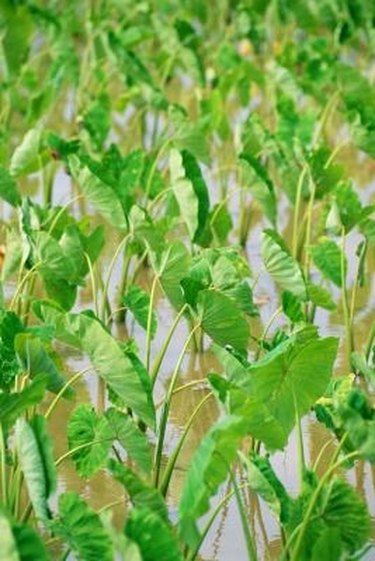
Elephant ear plants (Colocasia spp) are so named for the shape of their leaves. Some varieties not only mimic the shape but also the size of an elephant's ear. Colocasia esculenta var. antiquorum, for example, has leaves that can be a foot wide and up to 20 inches long, according to the Clemson University Cooperative Extension. Elephant ears, which are also called taro plants, are tropical foliage plants and are susceptible primarily to fungal diseases that thrive in warm, wet conditions.
Phytophthora Leaf Blight
Video of the Day
Phytophthora blight is a fungal disease caused by the fungus Phytophthora colocasiae. This serious disease, which spreads on water, first appears as tiny round lesions on the leaves. The center of each lesion oozes a clear fluid that turns yellow or purple when it is dry. The spots, which are dark purple or brown, rapidly increase in size and merge. In addition, the leaves become covered with a white fuzzy material, which is the growth of the fungal spores. In time, the infected leaves collapse. In severe cases, the fungus can move down into the corm and destroy it as well. Copper fungicides can be used to prevent phytophthora leaf blight. They should be sprayed on the plants when they are about 4 weeks old. Continued applications (every week in rainy weather and every other week when it's dry) are required until the plants are around 9 months old.
Video of the Day
Pythium Rot
Pythium rot is the most serious disease affecting elephant ear plants, according to the University of Hawaii. This common disease, which affects other plants (including potatoes and tomatoes) is caused by pythium parasites, not fungi as originally thought. Like fungi, they spread on water and thrive in very wet soils. In fact, the microorganisms love water so much that this disease is often simply called "water rot." Affected plants suffer overall decline or die quickly due to the corms rotting below ground. Seedlings are the most vulnerable. Pythium rot can be avoided by making sure the planting areas are sanitary and irrigation water is not contaminated.
Phyllosticta Leaf Spot
Phyllosticta leaf spot is not nearly as serious as pythium rot or phytophthora leaf blight, according to the University of Hawaii. In fact, it is only an aesthetic problem and does not threaten the life of the plant. For that reason, fungicides are rarely used to treat or prevent the fungal disease. Phyllosticta leaf spot presents as brown lesions on the leaves that dry and drop out of the foliage, resulting in a "shot up" appearance in the plant. The leaves may also look like they are sprinkled with black pepper, which is the fruiting bodies of the fungus. Like many other fungal diseases, the spores of this fungus travel on water, so care should be taken not to wet the foliage during irrigation.